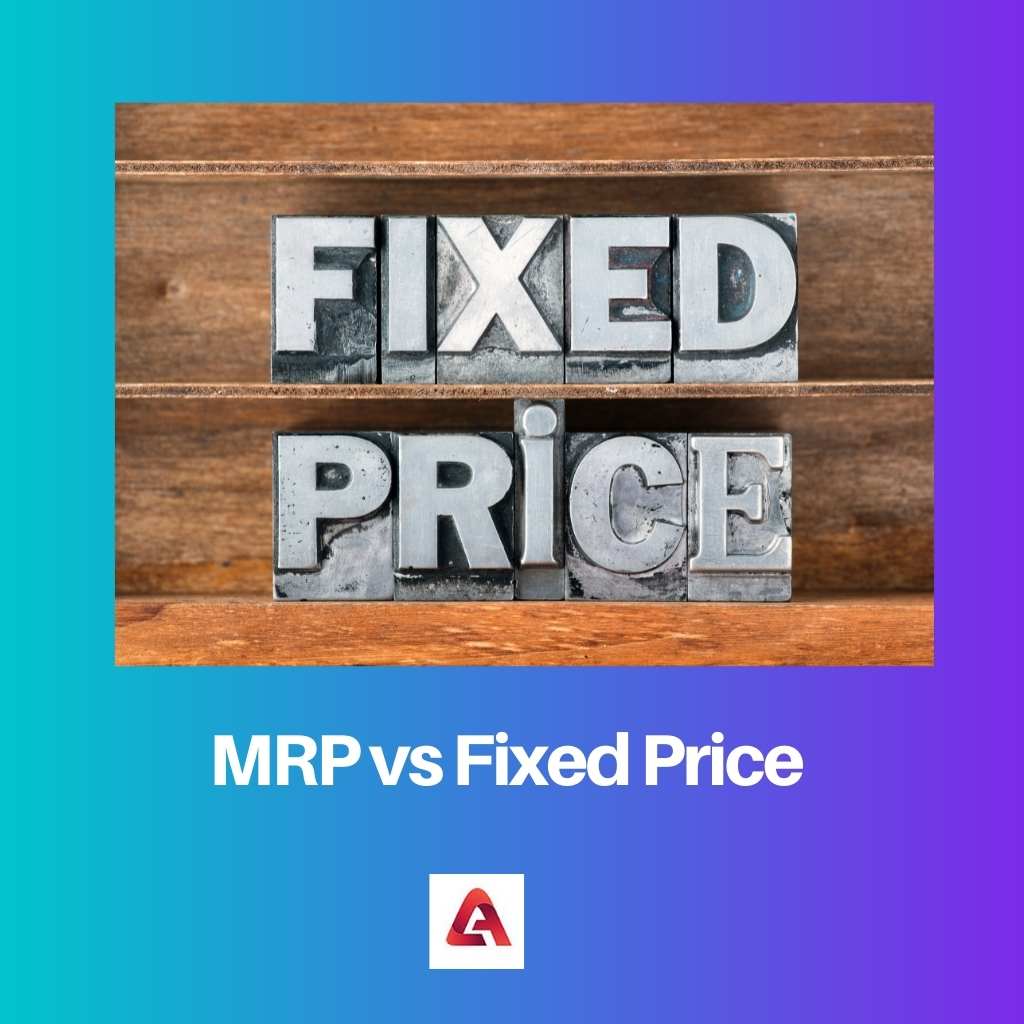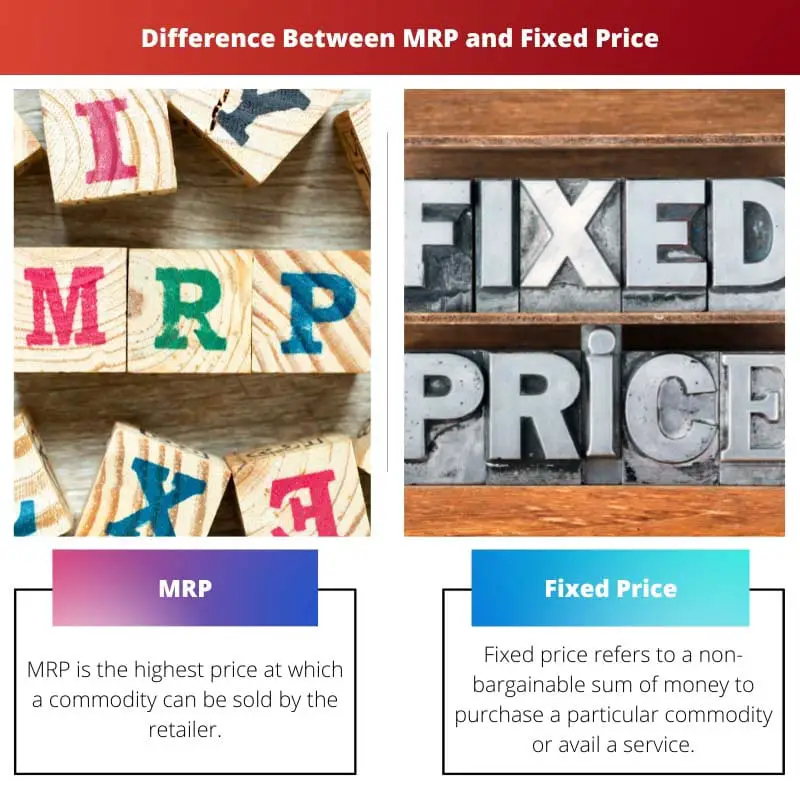Several everyday concepts that circle economics may be slightly difficult for some individuals to understand. The terms MRP and fixed price are two such concepts that have attracted considerable controversy.
While the terminologies may seem identical, MRP and fixed price vary on several grounds.
Key Takeaways
- MRP (Maximum Retail Price) is the highest price at which a product can be legally sold to consumers, including all taxes and charges. In contrast, a fixed price is a predetermined, non-negotiable cost for a product or service.
- MRP serves as a price ceiling to protect consumers from overcharging, whereas fixed pricing offers consistency and transparency for buyers and sellers.
- Both MRP and fixed pricing aim to provide clarity and fairness in the marketplace, but MRP specifically targets consumer protection, while fixed pricing focuses on simplifying transactions.
MRP vs Fixed Price
MRP is the maximum price that a manufacturer can charge for their product, as mandated by the government. Retailers are not allowed to sell the product above the MRP. Fixed price means a specific price that a retailer or seller sets for a product or service, which remains constant.

MRP is the highest price at which a commodity can be sold by the retailer. Usually, the Maximum Retail Price of every packaged commodity is listed on its packaging.
While countries like India and Bangladesh have adopted the MRP system, there are several other countries where the retailers determine the price of the commodity.
The validity of MRP has been intensely debated due to its limitation on the profits of retailers.
Fixed price refers to a non-bargainable sum of money to purchase a particular commodity or avail a service.
The fixed price of a commodity is determined by the government or the regulatory authorities or the seller of a service.
The most lucrative feature of fixed price is that it offers uniformity in the selling and buying process.
Comparison Table
| Parameters of Comparison | MRP | Fixed Price |
|---|---|---|
| Coverage | MRP is practiced only in India. | The policy of fixed price is prevalent in almost every country of the world. |
| Flexibility | A seller can sometimes sell a commodity at a price lower than the MRP. | Fixed price is non-changeable. |
| Purpose | The main purpose of MRP is to ensure that the sellers don’t exploit the consumers to earn higher profits. | The main purpose of fixed price is to ensure uniformity of goods in different areas. |
| Determiner | MRP is determined by manufacturers. | Fixed price is determined by government authorities or the price regulation agencies. |
| Examples | Some MRP items are bicycles and air conditioners. | Some fixed price items are salt packets, matchboxes, and cookie cans. |
What is MRP?
MRP stands for Maximum Retail Price. By definition, MRP refers to the highest price at which a product can be sold. MRP is a practice followed by India.
There are certain situations wherein the retailer may choose to sell the product at a price lower than the MRP. Sometimes, sellers may choose to sell their products below the MRP to attract more customers.
The main objective behind introducing the MRP system was to increase the awareness of customers regarding the price of various products.
At the same time, the Maximum Retail Price policy aims at discouraging suppliers from storing goods to increase prices in the future.
Today, every item from a packet of candies to an air conditioner has its MRP listed on the packaging.
The manufacturers must print the MRP of a product on its package. However, MRP has been criticized on several grounds.
It is suggested by some that this system stands incompatible with the free market system. The primary reason for this stance is that it is manufacturers who have the right to determine the profits that the retailers are going to make.
In addition, retailers may choose to increase their profits by charging overhead costs. Examples of such instances include charging for cooling the cold drinks, or the storage costs of commodities.
Non-packed commodities like services or essential commodities sold loose are not charged the MRP. Thus, the policy of Maximum Retail Price continues to be a conflicted practice.
What is the Fixed Price?
Fixed price refers to the price allotted to a commodity or a service that is not open to bargaining. There can be several reasons why the price is fixed.
For instance, the seller may choose to set a particular price or because the authorities under price control have chosen to regulate that price.
Although bargaining is a common practice in some countries of the world, fixed price tends to be the norm in most others.
The major advantage of fixed price is that it is a uniform price for all customers. For instance, the price of a packet of chips sold in the general store is the same for all consumers.
Several agents determine the fixed price. The most credible source is the government which fixes the price for a particular service such as governmental services.
The word fixed price is speculated to have originated in the period 1905-1910. The fixed price of a commodity or a service is subject to change across different regions and countries.
For instance, a packet of biscuits that may cost one dollar in the United States of America may round up to eight rupees in India.
A fixed price shop or mall offers a more convenient shopping experience than a bargaining shop. The primary reason for this is that the customer has no choice of bargaining.
Therefore, fixed price offers the sellers a pre-determined price for their commodity or services.
Main Differences Between MRP and Fixed Price
- MRP is the upper limit price of a commodity whereas fixed price is the non-changeable price of a commodity or service.
- While MRP is determined by the manufacturers of the commodity, fixed price is determined by different authorities such as the government or the international price regulation agencies.
- MRP is open to bargaining in some scenarios. On the other hand, fixed price is non-negotiable.
- MRP is a policy practised only in India, whereas fixed price is commonly found in countries like the United States of America and Canada.
- Examples of MRP items are refrigerators and washing machines. In contrast, examples of fixed-price items are sugar and oil.

